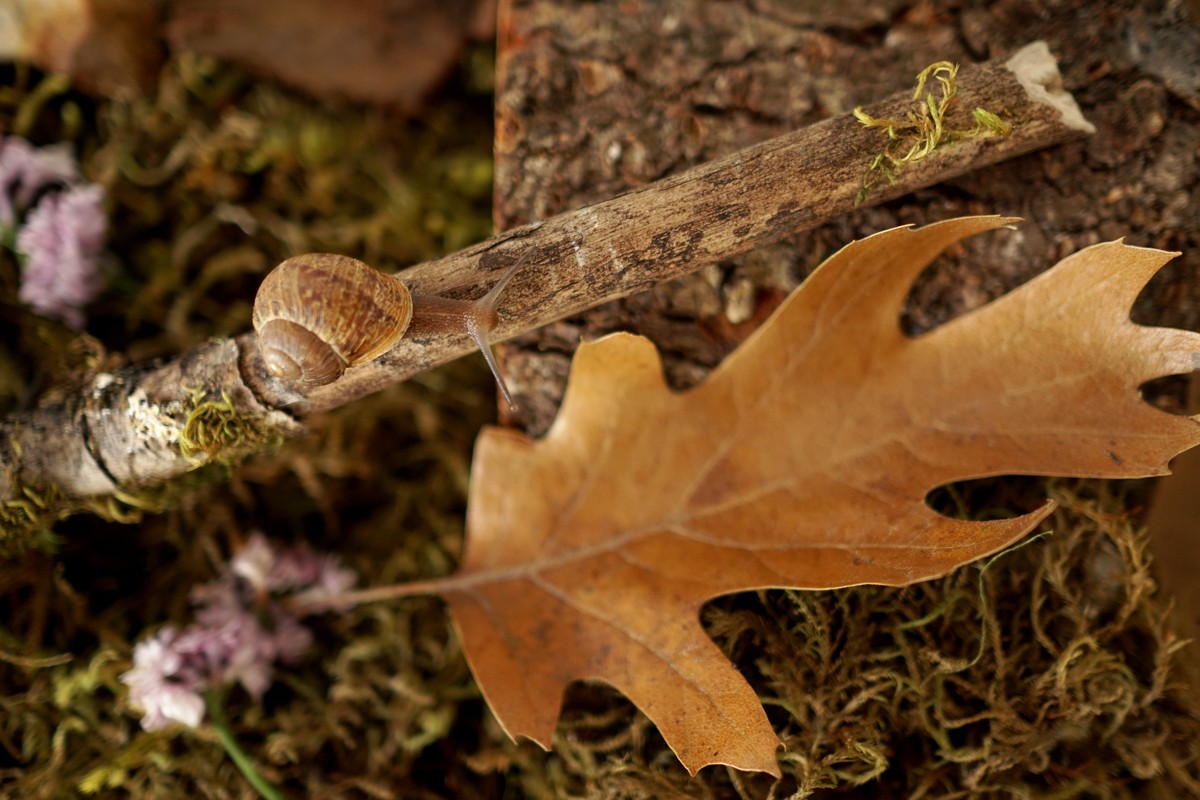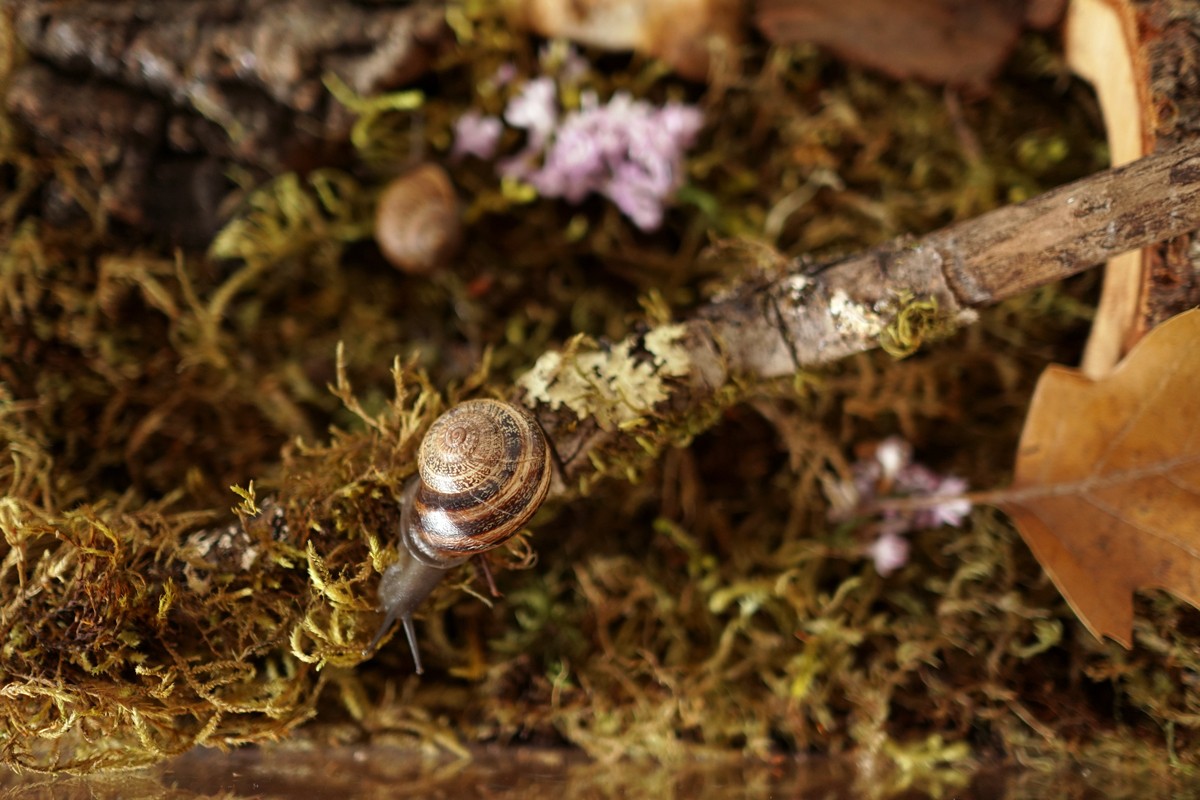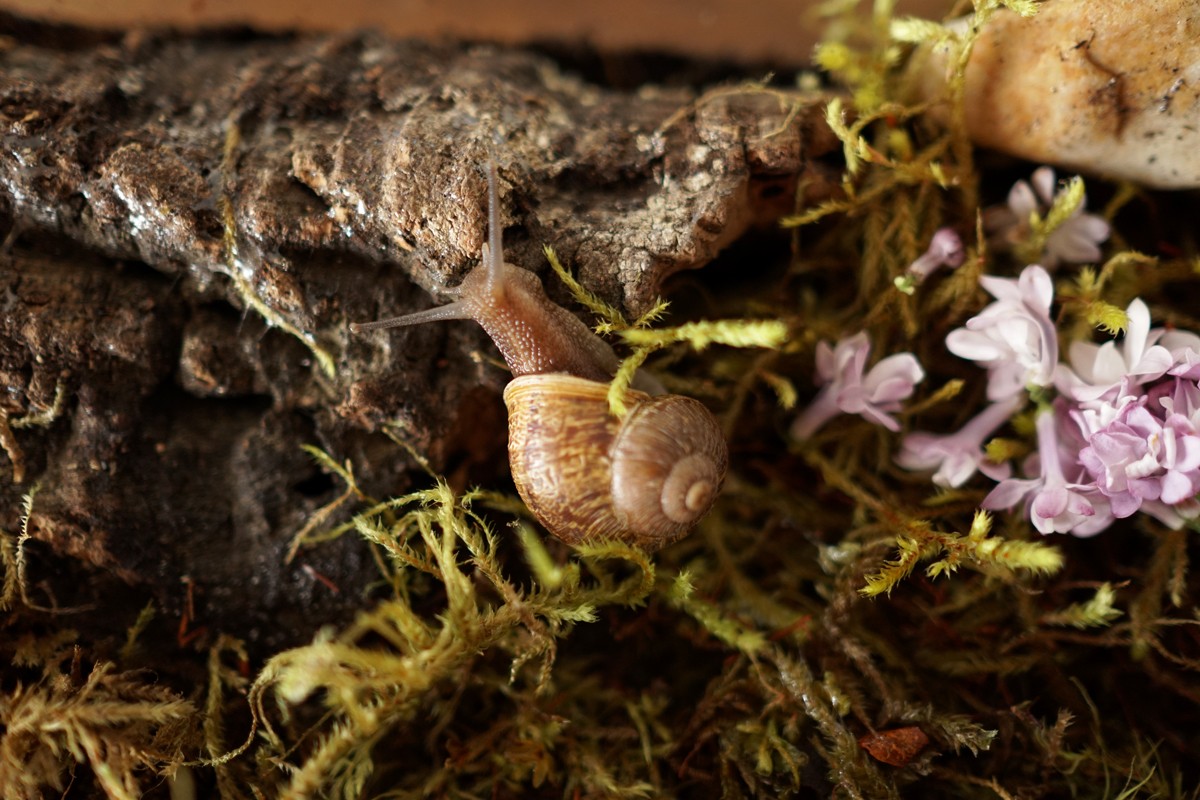Are Snails Easy Pets to care for, even for beginners? Absolutely, snails can be surprisingly easy and rewarding pets, perfect for those seeking a low-maintenance companion. At PETS.EDU.VN, we believe everyone should experience the joy of pet ownership, and snails offer a unique and accessible entry point. Delve into the simplicity of snail keeping with our comprehensive guide, unveiling essential snail care tips, terrarium setup advice, and the wonders of these fascinating mollusks, ensuring your pet snail thrives in its new home.
1. Understanding the Appeal of Snails as Pets
Why are snails gaining popularity as pets?
Snails offer a unique appeal, especially for those seeking low-maintenance, quiet companions. Unlike more demanding pets, snails require minimal attention and space, making them ideal for apartment dwellers or individuals with busy lifestyles. Their gentle nature and fascinating behaviors can be quite captivating to observe.
- Low Maintenance: Snails are relatively low-maintenance pets, requiring minimal daily care compared to other animals.
- Quiet Companions: They don’t make noise, which can be a significant advantage for people living in close quarters.
- Educational Value: Observing snails can be an educational experience, especially for children, teaching them about nature and responsibility.
- Space-Saving: Snails don’t need a lot of space, making them suitable for small living environments.
- Cost-Effective: Setting up and maintaining a snail habitat is generally inexpensive.
2. Are Snails Easy Pets? Debunking the Myths
What common misconceptions exist about snails as pets?
Despite their ease of care, some misconceptions surround snail ownership. Many believe snails are dirty or boring, but with proper habitat maintenance and enrichment, they can be fascinating and hygienic pets. Another myth is that all snails are pests, ignoring the fact that many species thrive in captivity and don’t pose a threat to gardens.
- Myth: Snails are Dirty: With regular cleaning of their terrarium, snails are quite clean pets.
- Myth: Snails are Boring: Snails exhibit interesting behaviors, such as burrowing, climbing, and interacting with their environment, which can be entertaining to observe.
- Myth: All Snails are Pests: Pet snails are typically different species from garden pests and won’t damage your plants.
- Myth: Snails are Fragile: While they need gentle handling, snails are relatively hardy creatures when kept in proper conditions.
- Myth: Snails Don’t Need Interaction: Although not cuddly, snails benefit from a stimulating environment and occasional interaction with their owners.
3. Choosing the Right Snail Species for You
What are the best snail species for beginner pet owners?
Several snail species are well-suited for beginners. The Giant African Land Snail (GALS) is popular due to its size and ease of handling. Other good options include Garden Snails and Milk Snails, known for their hardiness and adaptability. Researching each species’ specific needs is crucial before bringing one home.
-
Giant African Land Snail (GALS): Large and easy to handle, GALS are a popular choice for beginners.
-
Garden Snail: Hardy and adaptable, Garden Snails are a good option for those new to snail keeping.
-
Milk Snail: These snails are known for their beautiful white shells and relatively simple care requirements.
Snail Species Size Temperament Care Level Special Needs Giant African Land Snail Large Docile Easy Requires a spacious terrarium Garden Snail Medium Active Easy Adaptable to various conditions Milk Snail Small Calm Easy Needs a calcium-rich environment 


4. Setting Up Your Snail’s Terrarium: A Step-by-Step Guide
How do I create the perfect habitat for my pet snail?
Creating the right terrarium is essential for your snail’s health and happiness. Start with a glass or plastic tank, adding a substrate of coconut coir or sterilized soil. Include hiding places like cork bark or small pots, and maintain humidity by misting regularly. A shallow water dish and a secure lid are also necessary.
- Choose the Right Tank: A glass or plastic terrarium with a secure, ventilated lid is ideal. The size depends on the number of snails you plan to keep.
- Add Substrate: Use a few inches of coconut coir or sterilized soil as a substrate. Avoid soils with pesticides or fertilizers.
- Provide Hiding Places: Include cork bark, small pots, or other decorations where snails can hide and feel secure.
- Maintain Humidity: Mist the terrarium regularly with filtered water to keep the substrate moist but not soggy.
- Add a Water Dish: Provide a shallow dish of water for snails to drink and bathe in.
- Secure the Lid: Ensure the lid is secure to prevent snails from escaping.
5. Essential Terrarium Equipment for Happy Snails
What equipment is necessary for a thriving snail terrarium?
Beyond the basics, certain equipment can enhance your snail’s terrarium. A hygrometer helps monitor humidity levels, while a thermometer ensures the temperature is within the ideal range. A spray bottle is useful for misting, and a small feeding dish keeps food contained and clean.
- Hygrometer: Measures humidity levels to ensure the terrarium is adequately moist.
- Thermometer: Monitors temperature to maintain the ideal range for your snail species.
- Spray Bottle: Used for misting the terrarium to maintain humidity.
- Feeding Dish: Keeps food contained and prevents it from contaminating the substrate.
6. Ideal Temperature and Humidity Levels for Snails
What are the optimal environmental conditions for snail health?
Maintaining the correct temperature and humidity is crucial for snail health. Most snails thrive in temperatures between 65-75°F (18-24°C) and humidity levels of 70-80%. Regular monitoring and adjustments are necessary to keep these conditions stable.
- Temperature: 65-75°F (18-24°C) is ideal for most snail species.
- Humidity: Maintain humidity levels between 70-80% by misting regularly.
7. What Do Snails Eat? A Guide to Snail Nutrition
What is the best diet for pet snails?
Snails are herbivores and require a varied diet of fresh fruits, vegetables, and a calcium source. Leafy greens, carrots, cucumber, and apples are good choices. Always wash food thoroughly and provide a calcium supplement like cuttlebone for shell health.
- Leafy Greens: Lettuce, kale, and spinach provide essential nutrients.
- Vegetables: Carrots, cucumber, and zucchini are good sources of vitamins and minerals.
- Fruits: Apples, bananas, and berries can be offered in moderation.
- Calcium Source: Cuttlebone is essential for maintaining a healthy shell.
- Protein: Cooked egg can be provided, a small amount once a week
8. Safe and Unsafe Foods for Your Pet Snail
What foods should I avoid feeding my snail?
Some foods are harmful to snails and should be avoided. These include salty foods, citrus fruits, processed foods, and anything containing pesticides. Always research before introducing new foods to your snail’s diet.
- Salty Foods: Salt can be toxic to snails.
- Citrus Fruits: Acidic fruits like oranges and lemons can harm snails.
- Processed Foods: Avoid anything with additives, preservatives, or artificial flavors.
- Pesticides: Always wash food thoroughly to remove any traces of pesticides.
9. Maintaining a Clean and Healthy Snail Habitat
How often should I clean my snail’s terrarium?
Regular cleaning is essential for maintaining a healthy snail habitat. Remove uneaten food daily and perform a thorough cleaning of the terrarium once or twice a month, replacing the substrate and washing decorations.
- Daily: Remove uneaten food to prevent mold and bacteria growth.
- Weekly: Check the substrate for cleanliness and remove any waste.
- Monthly: Replace the substrate and wash decorations with warm, soapy water.
10. Recognizing Signs of a Healthy Snail
How can I tell if my snail is healthy?
A healthy snail is active, has a smooth, intact shell, and eats regularly. Signs of illness include lethargy, loss of appetite, a cracked or damaged shell, and unusual behavior.
- Active: A healthy snail will be active and curious, exploring its environment.
- Smooth Shell: The shell should be smooth, intact, and free from cracks or damage.
- Good Appetite: A healthy snail will eat regularly and show interest in food.
11. Common Snail Health Issues and How to Address Them
What health problems can affect pet snails?
Snails can be susceptible to certain health issues, including shell damage, parasite infestations, and bacterial infections. Addressing these problems promptly with proper care and, if necessary, veterinary attention is crucial.
- Shell Damage: Can be caused by falls or improper handling. Repair minor cracks with eggshell membrane or consult a vet for severe damage.
- Parasites: Mites and other parasites can infest snails. Quarantine affected snails and clean the terrarium thoroughly.
- Bacterial Infections: Can cause lethargy and loss of appetite. Consult a vet for antibiotic treatment.
12. Safe Handling Techniques for Snails
How do I handle my snail without hurting it?
Handling snails requires gentle techniques. Always wash your hands before and after handling to prevent the spread of bacteria. Gently pick up the snail by supporting its body, avoiding pulling on its shell.
- Wash Hands: Always wash your hands before and after handling snails.
- Gentle Grip: Gently pick up the snail by supporting its body.
- Avoid Shell Pulling: Never pull on the snail’s shell.
13. Encouraging Natural Behaviors in Your Snail’s Habitat
How can I make my snail’s terrarium more stimulating?
Enriching your snail’s environment encourages natural behaviors and prevents boredom. Provide climbing structures, hiding places, and a variety of textures to explore. Rotating decorations and introducing new foods can also keep things interesting.
- Climbing Structures: Add branches, cork bark, or other items for snails to climb on.
- Hiding Places: Provide caves, pots, or dense foliage where snails can hide and feel secure.
- Variety of Textures: Use different substrates and decorations to create a stimulating environment.
- Rotate Decorations: Change the layout of the terrarium regularly to keep things interesting.
- Introduce New Foods: Offer a variety of fruits and vegetables to keep your snail’s diet exciting.
14. The Lifespan of a Pet Snail: What to Expect
How long do pet snails live?
The lifespan of a pet snail varies depending on the species and care provided. Generally, snails can live from 1 to 5 years, with some species like the Giant African Land Snail living up to 7 years or more with proper care.
- Average Lifespan: 1-5 years
- Giant African Land Snail: Up to 7 years or more with proper care
15. Breeding Snails: Is It Right for You?
Should I breed my pet snails?
Breeding snails can be a rewarding experience but requires careful consideration. Snails are prolific breeders, and you’ll need to be prepared to care for numerous offspring. Understanding the specific breeding requirements of your snail species is essential.
- Prolific Breeders: Snails can lay hundreds of eggs at a time.
- Space Requirements: Be prepared to house and care for a large number of snails.
- Species-Specific Needs: Research the specific breeding requirements of your snail species.
16. What to Do with Baby Snails
What should I do if my snails lay eggs?
If your snails lay eggs, you have a few options. You can remove and freeze the eggs to prevent hatching, or you can allow them to hatch and care for the baby snails. Baby snails require a similar environment and diet as adults but need smaller food pieces.
- Remove and Freeze: This prevents the eggs from hatching.
- Allow Hatching: Prepare to care for a large number of baby snails.
- Provide Smaller Food: Baby snails need smaller pieces of food that are easy to eat.
17. Finding a Veterinarian for Your Pet Snail
Do snails need veterinary care?
While snails are low-maintenance, they may occasionally require veterinary care. Finding a vet experienced with invertebrates can be challenging but is important for addressing health issues like infections or severe shell damage.
- Invertebrate Vet: Look for a vet with experience treating invertebrates.
- Address Health Issues: Prompt veterinary care is essential for addressing infections or severe shell damage.
18. The Cost of Keeping Snails as Pets
How much does it cost to keep snails as pets?
Keeping snails as pets is relatively inexpensive. Initial costs include the terrarium, substrate, and decorations. Ongoing costs include food, occasional substrate replacement, and potential veterinary care.
- Initial Costs: Terrarium, substrate, decorations
- Ongoing Costs: Food, substrate replacement, veterinary care
19. Ethical Considerations of Snail Ownership
Is it ethical to keep snails as pets?
Ethical snail ownership involves providing a suitable habitat, proper care, and preventing the release of non-native species into the wild. Ensuring your snail’s needs are met and avoiding harm is crucial.
- Suitable Habitat: Provide a terrarium that meets the snail’s needs for space, humidity, and temperature.
- Proper Care: Ensure the snail receives a varied diet, regular cleaning, and prompt veterinary care when needed.
- Prevent Release: Never release non-native snails into the wild, as they can become invasive species.
20. Snail Ownership and Children: A Learning Opportunity
Are snails good pets for children?
Snails can be excellent pets for children, teaching them about responsibility, nature, and gentle handling. Adult supervision is necessary to ensure children handle snails properly and maintain the terrarium.
- Responsibility: Children can learn about caring for another living being.
- Nature Education: Snails offer a hands-on learning experience about nature and biology.
- Gentle Handling: Children can develop gentle handling skills.
- Adult Supervision: Adult supervision is necessary to ensure proper care and handling.
21. Alternatives to Wild-Caught Snails
Where can I get pet snails?
Avoid collecting snails from the wild, as this can harm local ecosystems. Instead, purchase snails from reputable breeders or pet stores that specialize in invertebrates. This ensures you’re getting a healthy snail that is suitable for captivity.
- Reputable Breeders: Purchase snails from breeders who prioritize health and ethical practices.
- Pet Stores: Look for pet stores that specialize in invertebrates.
- Avoid Wild-Caught: Collecting snails from the wild can harm local ecosystems.
22. Handling Snails Safely: Protecting Yourself and Your Pet
How do I protect myself from germs when handling snails?
Always wash your hands thoroughly with soap and water after handling snails to prevent the spread of bacteria. Avoid touching your face or mouth while handling snails, and supervise children closely to ensure they follow these precautions.
- Wash Hands: Always wash your hands thoroughly after handling snails.
- Avoid Touching Face: Prevent the spread of bacteria by avoiding touching your face or mouth.
- Supervise Children: Ensure children follow these precautions when handling snails.
23. Can Snails Recognize Their Owners?
Do snails form bonds with humans?
While snails don’t form the same kind of bonds as mammals, they can become accustomed to their owners’ presence and may exhibit behaviors indicating recognition, such as moving towards a familiar hand.
- Accustomed to Presence: Snails can become used to their owners’ presence.
- Behavioral Recognition: They may move towards a familiar hand or exhibit other signs of recognition.
24. Legal Considerations for Snail Ownership
Are there any restrictions on owning snails in my area?
Some areas have restrictions on owning certain snail species, particularly Giant African Land Snails, due to their potential to become invasive. Check your local regulations before acquiring a pet snail to ensure you comply with all laws.
- Invasive Species: Some snail species are considered invasive and may be restricted.
- Local Regulations: Check your local regulations before acquiring a pet snail.
25. Preparing for Vacation: Snail Care While You’re Away
How can I make sure my snail is taken care of when I’m on vacation?
Snails can be left unattended for short periods, but for longer vacations, arrange for a friend or pet sitter to check on them. Ensure they have fresh food, water, and that the terrarium is misted regularly to maintain humidity.
- Short Periods: Snails can be left unattended for a few days with fresh food and water.
- Longer Vacations: Arrange for a friend or pet sitter to check on them.
- Maintain Humidity: Ensure the terrarium is misted regularly to maintain humidity.
26. Are Snails Easy Pets? Space Requirements
How much space do snails need?
Snails don’t require a lot of space. The general rule is 1 gallon per snail. They do not need a heat source. Make sure that your enclosure has ventilation and a removable, tight fitting lid that locks in place. Choosing a good terrarium is important because it’ll make it easier to maintain the temperature and humidity of the habitat.
27. Are Snails Easy Pets? Social Needs
Do snails get lonely?
Snails enjoy company. Like any other pet, you’ll need a couple of basic things for them— a proper habitat and a constant supply of food. We’ve had our snails for a couple of years now and they’ve really become a part of the family.
28. Are Snails Easy Pets? The Joy of Snail Watching
What’s so great about watching snails?
Garden snails are herbivores and love fresh raw vegetables and fruits (avoid acidic fruits) as well as a calcium source (for their shell) and protein. They need a wide varied diet. A few specific things ours love are: leafy greens, carrots, dandelion leaves, cucumber, apple and flowers. We feed them daily. Always clean food before feeding it to them to remove any traces of things that could be harmful for them. Also add a shallow dish of filtered water for them to drink or play in. We handle our snails often and they are absolutely safe to handle— just as long as you make sure that you and your children always wash your hands thoroughly before and after handing them. Touching any soft of critter can expose you to pathogens, so make sure that your children do not put their hands in their mouth, rub their eyes or handle food before washing their hands well. Safety first.
29. Are Snails Easy Pets? Choosing the Right Substrate
What is the best substrate for snails?
Add a few inches of pesticide/chemical/fertilizer-free substrate to the bottom. Do NOT use bagged potting soil as it may contain harmful chemicals. Snails like to burrow, so you should also avoid using sand, pebbles or gravel. I recommend using a sterilized soil that is specifically sold for pets for terrariums. I don’t advise using soil from your garden as it can contain parasites and other things you wouldn’t want in your home— but if you choose to, you can use one of these methods to try to sterilize it before using. We then added a thick layer of sphagnum moss, which helps to maintain a good level of humidity and adds necessary soft padding (the snails also like to nibble at it and bury themselves into it). Peat moss (is not recommended because it is too acidic. Moisten your soil so that it is damp.
30. Are Snails Easy Pets? Enrichment
How can I enrich my snail’s life?
Snails love to climb. Add sticks, pieces of bark, branches and leaves to your habitat. We no longer use rocks in our habitat because they like to climb the sides of the tank so there is a risk of them falling and breaking their shell. You’ll want to provide places for your snail(s) to crawl as well as a hiding place. We added a little hollowed out log cave and created a nook with a large oak leaf. You can also add real plants or grasses. Make sure you research the plants that you plan to add to make sure that they are not toxic to snails.
31. Are Snails Easy Pets? Where to Place the Terrarium
Where should I put the terrarium?
Choose a location for your terrarium that is out of direct sunlight. Mist the substrate inside of the terrarium as needed with filtered water inside of a clean spray bottle to maintain humidity. You want everything to be moist, but not soggy. We mist ours daily with a fine mist spray bottle. Snails prefer moisture and will be most active if you maintain an ideal environment for them.
32. Are Snails Easy Pets? Final Thoughts
Are snails the right pet for you?
If you’re looking for a low-maintenance, quiet, and fascinating pet, snails might be the perfect choice. With proper care and attention to their needs, snails can bring joy and education to your life.
FAQ: Frequently Asked Questions About Snail Care
- Are snails easy to care for? Yes, snails are relatively easy to care for, requiring minimal daily attention.
- What do snails eat? Snails eat a variety of fresh fruits, vegetables, and a calcium source like cuttlebone.
- How often should I clean my snail’s terrarium? Remove uneaten food daily and perform a thorough cleaning once or twice a month.
- What is the ideal temperature for snails? Most snails thrive in temperatures between 65-75°F (18-24°C).
- How long do pet snails live? Snails can live from 1 to 5 years, with some species living longer.
- Can snails recognize their owners? Snails can become accustomed to their owners’ presence.
- Do snails need veterinary care? Snails may occasionally require veterinary care for health issues.
- Are snails good pets for children? Yes, snails can be excellent pets for children with adult supervision.
- What should I do if my snails lay eggs? You can remove and freeze the eggs or allow them to hatch and care for the baby snails.
- Are there any restrictions on owning snails in my area? Check your local regulations before acquiring a pet snail.
Caring for snails can be an incredibly rewarding experience, offering a unique glimpse into the natural world right in your home. By providing the right environment, diet, and care, you can ensure your snail thrives and brings you years of fascination.
Ready to embark on your snail-keeping journey? At PETS.EDU.VN, we understand the challenges of finding reliable pet care information and the desire for specialized services. If you’re eager to dive deeper into the world of snails or any other pet, visit PETS.EDU.VN today. Our extensive resources and expert advice will guide you every step of the way. Whether you need detailed care guides, tips on handling specific health issues, or recommendations for the best local pet services, we’ve got you covered. Don’t hesitate—enhance your pet care knowledge and give your beloved snails the best possible life with PETS.EDU.VN! Contact us at 789 Paw Lane, Petville, CA 91234, United States, or via Whatsapp at +1 555-987-6543. Visit our website at pets.edu.vn. Explore the wonders of pet ownership with us!
